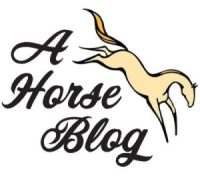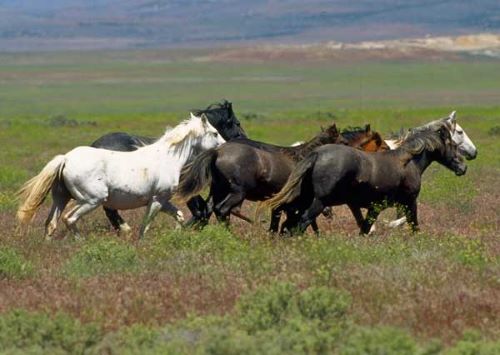Last Updated on June 16, 2025 by adminahb
by William E. Simpson II
We’ve been hard at work studying the ecology & ethology of our herd of 200 free-roaming, naturally living heritage horses and conducting research on their environmental benefits with our students from Cal State.
And in the evenings, sometimes until 2:00 AM, we’ve been writing research papers to help provide additional information to our followers and wild horse advocates who are tired of seeing the same old BLM wild horse management train wreck, now going into 30 years+ and with the help of some so-called wild horse nonprofits who are literally assisting the BLM’s path to extinction for the horses by supporting and using sterilization programs using the chemicals PZP & GonaCon.
There is nothing ‘appropriate’ about the ‘AML’ for horse populations established by BLM… the ‘A’ truly stands for Arbitrary and is genetically and ecologically inappropriate.
Check out our latest research paper on ‘AML’ and learn how reckless the Bureau of Land Management is managing the relatively few remaining American wild horses in concert with people supporting sterilization (a.k.a.: Fertility Control) who are now integrated into the Wild Horse Caucus, a further dagger into the survivability of American wild horses.
Supporting our nonprofit ‘Wild Horse Fire Brigade’ is supporting wild horses.
Abstract
This report amplifies my (William E. Simpson II) (2025) study, Sustaining Wild Horse Populations in BLM Managed Herds: Foal Requirements for Genetic and Population Stability, by integrating data on natural predation, ecological roles, and the human-caused factors exacerbating wild horse overpopulation. The Bureau of Land Management’s (BLM) Appropriate Management Level (AML), set at 26,785 horses and burros across 177 Herd Management Areas (HMAs), is critiqued as arbitrary and inappropriate, particularly following the 2024 Supreme Court decision to overturn Chevron Deference (Loper Bright Enterprises v. Raimondo). The AML fails to account for genetic sustainability, ecological contributions, and natural population controls like apex predation. On BLM and U.S. Forest Service (USFS) lands with livestock grazing allotments, government hunters, and ranchers decimate predators (e.g., mountain lions, wolves) to protect livestock, creating predator-free environments that artificially inflate wild horse populations — a human caused issue misattributed to horses. Studies, such as those in the Great Basin, show wild horses comprise 59.6% of mountain lion diets, highlighting predation’s regulatory role. The Wild Horse Fire Brigade (WHFB) rewilding plan, relocating 50,000 horses to 30 million conflict free acres, is proposed as a sustainable solution to ensure genetic viability, restore ecological balance, and reduce management costs.
Introduction
Wild horses (Equus caballus), native to North America with a 1.7–2-million-year evolutionary history (Shapiro et al., 2013), are managed by the BLM and USFS under the 1971 Wild Free Roaming Horses and Burros Act. The current population of ~73,520 exceeds the AML of 26,785, triggering costly roundups and fertility control (PZP/GonaCon) costing over $100 million annually (Miller, 2025). Simpson’s (2025) study highlights that ~88 HMAs have ≤100 adults, risking extinction due to inbreeding and genetic erosion, with sterilization reducing foal production by 46–65%, necessitating infeasible reproductive rates (2.5–2.7 foals per fertile mare). Natural selection, including predation by apex predators like mountain lions and wolves, historically regulated horse populations (Turner & Morrison, 2001). However, on BLM and USFS lands with livestock grazing allotments, predator suppression by government hunters (e.g., USDA Wildlife Services) and ranchers creates predator-free zones, leading to human-caused wild horse overpopulation (Beever et al., 2019). This report amplifies Simpson’s findings by integrating predation dynamics, ecological benefits (e.g., wildfire mitigation), economic tradeoffs, and ethical concerns, arguing that the AML is arbitrary and inappropriate, especially post Chevron Deference, due to its livestock bias and disregard for ecological science (Linklater et al., 2016).
Methods
This analysis builds on Simpson’s (2025) methodology, which uses non-BLM sources to estimate foal requirements for genetic and population stability. Key assumptions include:
- Survival Rate: 40% foal survival to breeding age (2–3 years) (Kirkpatrick & Fazio, 1994).
- Reproductive Rate: Mares produce 0.85 foals annually over 15 years (Linklater et al., 2004).
- Genetic Sustainability: IUCN recommends herds of ≥500 adults for long term diversity (Ne = 50–100 short term) (Frankham et al., 2014).
- Sterilization Impact: PZP/GonaCon reduces foal output by 46–65% (Ransom et al., 2013).
Additional peer reviewed sources include:
- Predation Dynamics: Turner & Morrison (2001) on mountain lion predation (59.6% horse diet in Great Basin); Berger (2008) on wolf predation.
- Ecological Roles: Naundrup & Svenning (2015) on megaherbivore fire mitigation; Davies et al. (2014) on biodiversity benefits.
- Management Critiques: Linklater et al. (2016) and Hofreiter & Serpell (2014) on arbitrary population caps.
- Economic Data: BLM’s 2024 grazing fee reports; Miller (2025) on roundup costs.
- Ethical Frameworks: Humane Society (2023) on wildlife welfare. Calculations estimate foal needs, predation impacts, ecological benefits, and economic costs, critiquing AML’s scientific validity post Chevron Deference (Loper Bright Enterprises v. Raimondo, 2024).
Results
Foal Requirements
Simpson (2025) estimates 73,520 horses require 16,936–17,376 foals annually without sterilization, rising to 20,000–22,500 with 50–70% mare treatment. For 50,000 horses, this scales to 11,500–11,800 foals without sterilization, vs. 14,000–15,300 with it. Key findings:
- Small Herds (≤100 Adults, ~88 HMAs): Need 5,544–5,984 foals annually, but sterilization creates a ~3,520–4,000 foal deficit, requiring 2.5–2.7 foals per fertile mare — biologically infeasible (Ransom et al., 2013).
- Larger Herds (≥500 Adults, ~89 HMAs): Need ~11,392 foals, achievable with natural reproduction.
- Temporal Impact: Sterilization over 10 years could reduce Ne below 50 in 70% of small HMAs, risking 30–50% genetic diversity loss by 2040 (Nuñez et al., 2015).
Natural Predation and Population Control
Apex predators historically regulated wild horse populations through natural selection, targeting foals and weaker individuals to maintain genetic vigor and ecological balance (Turner & Morrison, 2001). In the Great Basin, wild horses comprise 59.6% of mountain lion diets, with predation significantly reducing population growth (Turner & Morrison, 2001). Wolves also prey on horses, particularly in regions like the BC Chilcotin, where they limit herd sizes (Berger, 2008). Other predators, like coyotes and bears, occasionally target foals but have less impact (Davies & Boyd, 2019). Predation ensures populations align with carrying capacity, reducing overgrazing risks. However, on BLM and USFS lands with livestock grazing allotments (12 million AUMs for livestock vs. 0.3 million for horses), predator suppression disrupts this balance. USDA Wildlife Services and ranchers kill ~80,000 predators annually, including mountain lions and wolves, to protect livestock (Beever et al., 2019). In Nevada (59% of U.S. wild horses), this correlates with herd growth rates of 20–25% annually, absent predation (BLM, 2024). This human caused overpopulation is misattributed to horses, justifying AML driven roundups.
Table 1: Predators of Wild Horses and Their Impact
| Predator | Region | Impact on Wild Horse Populations |
| Mountain Lions | Great Basin, Nevada | 59.6% of diet; regulate populations by preying on foals/weaker individuals (Turner & Morrison, 2001) |
| Wolves | BC Chilcotin, Canada | Major predator; controls population growth (Berger, 2008) |
| Coyotes | Western U.S. | Prey on young/injured horses; limited impact (Davies & Boyd, 2019) |
| Bears | Western U.S. | Occasional foal predation; minimal impact (Davies & Boyd, 2019) |
Ecological Contributions
Wild horses reduce wildfire risk by grazing fine fuels, potentially saving $1–2 billion annually in suppression costs (Naundrup & Svenning, 2015), offsetting BLM’s $30 million fertility control budget. They enhance soil carbon sequestration (~0.5–1 ton/ha/year), create water wells for wildlife, and promote seed dispersal, unlike cattle, benefiting biodiversity (Davies et al., 2014; Lundgren et al., 2018).
Economic Trade-Offs
BLM allocates 12 million AUMs to livestock vs. 0.3 million to horses, with grazing fees at $1.35/AUM (2024), generating ~$16 million. Livestock subsidies cost $500 million yearly, while roundups cost $100 million, with holding costs consuming two thirds of BLM’s $142 million budget (Miller, 2025). Rewilding could save $80 million annually by reducing roundups and generate $50 million/year via eco-tourism.
AML Critique
The AML (26,785) assumes horses compete with livestock, ignoring genetic needs (IUCN’s ≥500 adult requirement), ecological roles, and predation dynamics. Post-Chevron Deference (2024), AML lacks scientific justification, relying on 1970s-era livestock focused assessments (Linklater et al., 2016). Hofreiter & Serpell (2014) critique such caps as arbitrary, prioritizing economic interests over biodiversity.
Discussion
Human-Caused Overpopulation
Natural selection via predation maintained sustainable horse populations, with mountain lions (59.6% horse diet) and wolves culling weaker individuals (Turner & Morrison, 2001; Berger, 2008). On BLM and USFS lands, predator suppression (~80,000 predators killed/year) for livestock protection creates predator-free zones, causing horse populations to grow unchecked (Beever et al., 2019). Fencing further restricts horse movement, exacerbating overpopulation (Davies & Boyd, 2019). This human-caused issue, misattributed to horses, drives AML-justified roundups, which disrupt herds and increase compensatory reproduction (National Academies Press, 2013).
Why AML Is Arbitrary
- Outdated Assumptions: AML relies on 1970s range management, ignoring genetic (Hofreiter & Serpell, 2014), ecological (Naundrup & Svenning, 2015), and predation data (Turner & Morrison, 2001).
- Political Bias: AML favors cattle (12 million AUMs) over horses (0.3 million AUMs), reflecting ranching influence (Linklater et al., 2016).
- Post-Chevron Deference: The 2024 ruling reduces deference to AML, which lacks peer reviewed justification (Loper Bright Enterprises v. Raimondo, 2024).
- Predation Oversight: AML ignores natural population controls, perpetuating human-caused overpopulation (Beever et al., 2019).
Why AML Is Inappropriate
- Genetic Unsustainability: AML’s low caps produce insufficient foals (23 vs. 63–68 needed), risking genetic erosion (Linklater et al., 2004).
- Ecological Neglect: AML disregards wildfire mitigation ($1–2 billion/year savings) and biodiversity benefits (Lundgren et al., 2018).
- Economic Inefficiency: Roundups ($100 million/year) and fertility control ($30 million/year) outweigh rewilding’s savings (Miller, 2025).
- Ethical Violations: AML-driven roundups and sterilization disrupt herd dynamics, causing stress (Humane Society, 2023).
WHFB Rewilding Solution
Rewilding 50,000 horses to 30 million acres at 1 horse per 600 acres supports:
- Genetic Health: Herds ≥500 adults produce ~128 foals/herd, meeting IUCN standards.
- Ecological Benefits: Grazing reduces wildfire fuel, saving $1–2 billion/year.
- Economic Savings: Eliminates roundup costs ($80 million/year) and boosts eco-tourism.
- Predation Restoration: Conflict free wildlands allow predator recovery, naturally regulating populations (Turner & Morrison, 2001).
Recommendations
- Replace AML with IUCN Standards: Set targets at ≥500 adults/HMA to ensure genetic diversity.
- Adopt WHFB Rewilding: Relocate 50,000 horses to 30 million acres, phasing out sterilization.
- Restore Apex Predators: Reduce predator killing on public lands to enable natural population control.
- Redirect BLM Budget: Reallocate $130 million to rewilding, eco-tourism, and predator restoration.
- Legislative Reform: Amend the 1971 Act to prioritize ecological roles and predation dynamics.
- Public Education: Promote horses’ native status, ecological benefits, and predation’s role to counter livestock narratives.
Conclusion
The BLM’s AML is arbitrary and inappropriate, particularly post-Chevron Deference, as it ignores genetic sustainability, ecological contributions, and natural predation while prioritizing livestock. Predator suppression on BLM and USFS lands creates human-caused wild horse overpopulation, misattributed to horses, with studies showing horses comprise 59.6% of mountain lion diets in the Great Basin. The AML caps populations at 26,785, far below the 73,520 needed for sustainability, requiring 16,936–17,376 foals annually (20,000–22,500 with sterilization). WHFB’s rewilding, coupled with predator restoration, offers a sustainable, cost-effective solution to ensure wild horse survival and ecosystem health.
By: William E. Simpson II
June 13, 2025
© All Rights Reserved
Visit www.wildhorsefirebrigade.org for more information.

